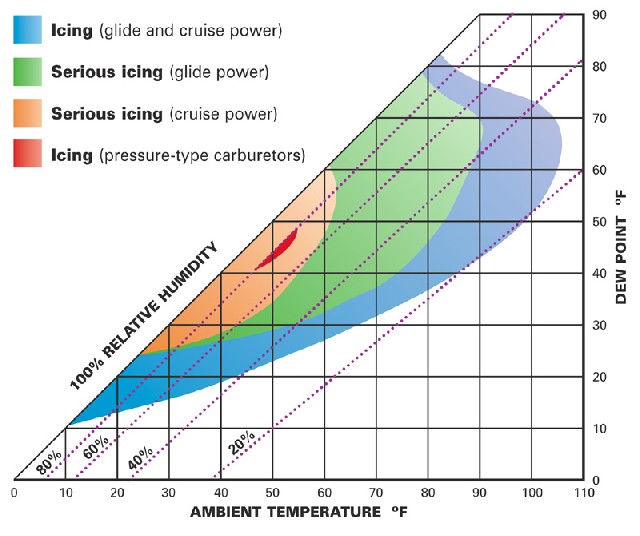the guy from antartica whose snow machine was stalling . . . . could not have had carburetor ice since he stated it was 40 below , , (Farenheit or Celcius - it doesn’t matter) and carb ice occurs only in a specific set of conditions. See the chart on:
http://www…arbice.jpg
The chart clearly shows no region in the -40F zone where carb ice will form. This one should be re-aired on “Stump the Chumps”!!
The chart doesn’t show a -40F zone at all.
that’s because carb icing does not occur at -40 . . . Google carb ice and you will see why.
Right, the chart begins at 0 degrees f. No title either. Since the flashpoint for gasoline is -45 degrees f, it seems pretty pausible that icing might occur in the carb at -40 degrees f.
I did as you suggested and googled “Carb Ice”. This is what I found:
This chart goes to I believe -20 Celsius.
It clearly shows Icing happens below 0?F
I think misterfixit1967 is probably correct, though I haven’t seen the chart. Carb icing requires that there be some appreciable moisture suspended in the air as water vapor, but -40F air is just so cold that I doubt it can hold enough vapor n suspension to cause carb icing.
According to this chart icing stops below about -16?C, 3?F.
The OPs chart shows about 10?F.
The outside temp may be -40…but inside an engine compartment could be a LOT hotter.
thanks for the updated chart. It kinda reinforces my statement “The chart clearly shows no region in the -40F zone where carb ice will form. This one should be re-aired on “Stump the Chumps”!!”
-40 air has very little moisture in it. And the source of the air is what is in question outside of the engine compartment. Granted it may be warmed up by the time it gets to the carb but along the way there is no source of moisture. In fact as the -40 outside air is warmed under the hood its relative humidity goes down considerably. Carb icing is probably not the cause of his problem. So what is his problem?? Any ideas out there??
The chart if im right shows icing can occur above freezing. I know icing occurs before -40 ive seen it and the humidity / dew point range is wide
So I looked it up and you are right. At 40 degrees f below zero, gasoline barely vaporizes, and these vapors must be fairly abundant for icing to occur.
Most likely, the snow machine is stalling because he is not using an additive to lower the flashpoint of gasoline, and more importanly, something called the fire point, the temperature at which combustion is sustainable. If the guy from antartica is using stale gasoline, it’s likely that the flash point is around -40 f, but the fire point is higher than -40 f, and this is the reason why the machine will start but quickly stall.
i dont understand where you guys are contributing fuel flash point to cab icing. Carb icing as i know it is ice build up where air is drawn into the carburetor
Under normal antarctic conditions, the 60 mph wind carries much snow into the air intake where it first is thawed by the hot engine (assuming the operator got the engine started)then this now saturated air is drawn into the carburetor where it freezes up again, stopping the machine more or less permanently…
There are places on this planet where humans simply do not belong. Antarctica is one of those places… Take away the Government money and they are GONE…
I think maybe people dont even belong where i live. It gets so cold here ive seen cows with there ears missing because they froze. Im sure cows arent supposed to be here. It should be illegal. I understand carb freeze up…i was asking how they figured that =gasoline flash point played into it…as far as i can tell it doesnt
ahhhhhhhhhh I hadn’t thought about wind-driven snow inside the engine compartment as a source of moisture!! Maybe he is having carb ice problems then afterall!! Would a solution be to filter the air somehow before it gets into the engine compartment or would that filter just ice up? Methinx getting them outta the Antartic is the only solution!!! The original guy in this story was leaving in a few days so it’s no longer his problem!! Now if every carb manufacturer had listened to Gus Fossum there would be no problem!!
filter and pre-heat
now I have to find my old Cessna 172 POH!
Quite a bit to be learned about this planet by looking at the poles and some times this look must be in person, denifinitly hard on men and equipment though.
Read the answer again. I agreed that the cause is not icing and suggested that the problem has to do with the temperatures at which gasoline will vaporize (and so catch fire) and sustain combustion. It’s pretty relevant that the temperature is -40 f and gasoline will not ignite at -45 f. If the gasoline is stale, the flashpoint will be higher than if it is fresh.
